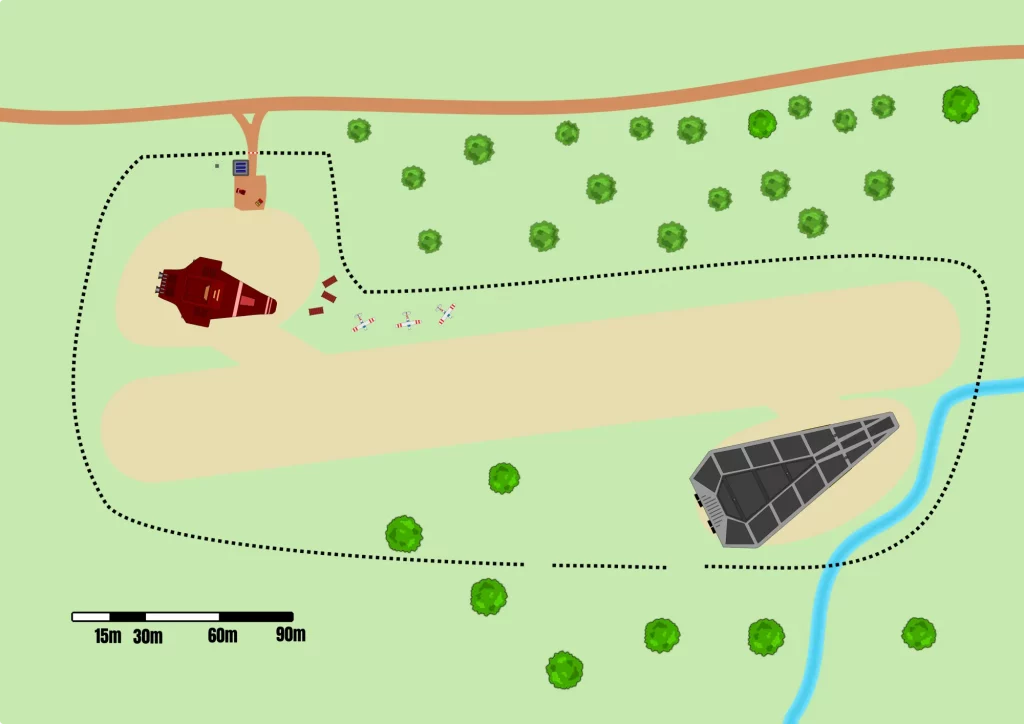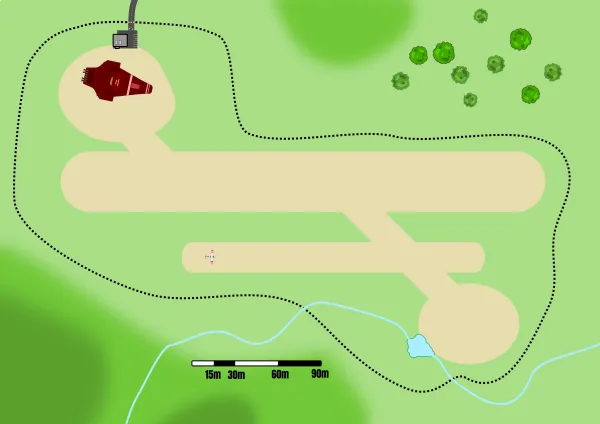Class E Starports

We haven’t had any gaming this week, so I’ve been working on some starship designs, and drawing some starport maps. The latter got me thinking about what exactly should be present at a class E starport, because it’s never really been entirely clear to me. Descriptions have ranged from an empty spot of land to something with an airstrip and a few basic buildings.
According to the description given in the Mongoose Traveller Companion, a class E port doesn’t consist of much:
Code E indicates what is often termed a ‘frontier installation’. A Class E port can be nothing more than a ‘usual place to land’ or a known safe area. There are no facilities as such, though there might be a settlement close by where ad-hoc services can be obtained.
However, this means there doesn’t seem to be that much difference between a class X (no port at all, land anywhere where it looks safe) and an E, which is just a spot on a map. Class D ports are the next stage up, and consist of a minimal set of facilities:
Code D is assigned to a very basic port. A Class D port is almost always a downport with no orbital component at all. Only unrefined fuel is available and no repair facilities are on offer; what facilities there are may be quite primitive.
Classic Traveller seems to go with ‘effectively nothing here, just a spot on a map’. This raises the question of what marks a class E as different from any other spot of land. It has some guarantee of being firm ground, but is that enough to encourage pilots to land there, rather than somewhere closer to the person they’re trading with? From my perspective, I think a class E deserves a little bit more than this. One of the most important features of a starport (at least in the Third Imperium) is that they are considered Imperium property, and subject to Imperium Law. This I think puts in the requirement that a starport needs to be able to identify itself.
This makes me think that even a class E port should have the following:
- A beacon, so that the port can be identified and located. This may also act as a receiver, to keep a record of ships landing, though this is normally reserved for D ports and above.
- A fence, wall or some other border, to mark the extrality line and keep sheep off the runway.
- Possibly some basic cover, as well as parking and links to the local transport network. It may also provide digital links in the form of WiFi access to the local internet, in the rare cases where a world has an internet, but doesn’t have broadly available standard connection protocols.
- Sufficient space to land at least one spacecraft up to 1,000dt in size.
- Preferably, a nearby water source to provide refuelling.
If you can’t get your goods from the port to the local markets, then there really isn’t any point in using the port, so there really do need to be transport links of some type. Transport links require that there is somewhere where cargo can be loaded and offloaded from, which means space for vehicles to park.
On a TL 2 world, ‘transport links’ may just be a dirt track big enough for a horse and cart, but there still needs to be something. Indeed, a low tech port may have a secondary need for a water source, to make travel easier.
The water source will be just that. A lake, river or stream from which a ship can collect water for processing. The water may not be clean, so fuel processing will be needed. On some worlds, the water may be frozen.
This actually matches with the definition for a Class I Starport in GURPS Traveller Starports (GURPS has its own definitions for ports, but classes I to V track quite closely with E to A). This mentions water, beacons, a fence and an ‘office module’ from a modular cutter.
Reality may mean that a few old cargo containers have been dumped here, with a desk and a few chairs inside for ‘business meetings’.
The fence marking the extrality line has a second advantage, in that it prevents sheep or other animals wandering onto the landing field. Legally, it marks the border between the local government and Imperium Law. Travellers who have broken local laws could in theory flee here and claim immunity. Whether villagers with shotguns and/or pitchforks respect the border though is another matter entirely.
Though technically the local government has no control over what goods are traded within the confines of the starport, there will rarely be any starport authority customs or security to prevent them from trying to enforce their own rules. Officially a complaint could be filed, but that may take weeks or months to be resolved. It might have long term consequences for the government if they repeatably interfere in trade, but that’s not going to help a group of Travellers who have just been arrested for dealing in locally restricted goods.
Size Requirements
So how big does a class E starport need to be? Starships in Traveller are quite large. Maybe surprisingly so. The drawing below shows a Far Trader to scale with a Cessna, Learjet and Boeing 737. Each square on the grid is 1.5m.

So even a class E port isn’t going to be the sort of small grass strip where you’d land a light aircraft. Most spacecraft had the advantage of M-Drives which will allow them to be more or less capable of VTOL, so a long runway probably isn’t necessary but may help on worlds where the gravity is Earth standard or higher. Another advantage for having an airstrip is that it allows it to be used by light aircraft (given sufficient TL), to make local distribution of goods easier.
The landing area will probably be packed dirt rather than tarmac. The latter will require lots of upkeep, and class E’s probably don’t get much of that. Most may expect a few ships a week, or maybe a month. Few will be interested in spending time filling in potholes. Though, if the trade is important to the locals, someone may be paid to check up on things a few times a year.
You probably want space for two or three smaller craft, though that’s probably the maximum.
So how big is this? In terms of landing strip, a Cessna needs about 260m of runway, so if the port also wants to cater for light aircraft then something in the order of 300m is probably going to be useful. If a spacecraft needs a landing strip, then it’s complete guesswork as to how big a strip is needed. The M-Drive throws physics out of the window, so we can’t base numbers on anything in the real world.
Since it gives a reasonable sized port, I’m going to assume 300-500m is ideal, depending on local gravity and atmosphere density. Thinner atmospheres will require longer landing strips. Mostly a landing strip will probably be used for local aircraft, and as a ‘clear zone’ for a spaceship to come in over, slowing for VTOL just before touchdown.
Landing a an E class port or better is a routine (6+) Piloting check, compared to 8+ in the wild. The lack of a landing strip may mean DM -1 to the check if there’s lots of ground clutter (such as trees) around the port.

This is a potential E class port. It has a wide landing strip, and two places for craft to park, one of which is close to a river. The 800t Python shown on the map barely fits, but the ground is firm enough to take a ship of this size. The fence that defines the border to the starport has been lacking upkeep, and there are a couple of broken sections near the river side pad.
A typical Far Trader or Subsidised Merchant have lengths of about 50m, so any landing area should probably be about 75-100m across at a minimum – more if multiple ships are being catered for. The Python is about 90m in length, so this sort of size also caters for bigger ships willing to squeeze into a spot barely large enough for them.
There is a small parking lot for ground vehicles, and a building for potential passengers to shelter from the wind and rain. Solar panels are on the roof, which power the radio beacon next to it.


The above two ports are similar in nature. The first has a secondary airstrip, probably reserved for light aircraft. It actually has a tarmac area for ground vehicles to park and a more extensive building. It’s still probably unmanned for the most part though.
The second is a port out in the middle of nowhere, with no nearby water source. It might have a well within the confines of the port which can be pumped for water. How quickly this refills will depend on a number of factors, but could be anything from hours to days or weeks. A water source in a dry area may only provide a few displacement tonnes of water a day.
Each displacement tonne of water produces 1.5 displacement tonnes of liquid hydrogen. This requires the hydrogen to be split from the water, and then cooled down to liquid temperatures. This produces unrefined fuel, but is good enough to be used in a jump drive with an increased risk of jump failure.
Ships which have fuel scoops come equipped with hoses for collecting water, splitting hydrogen and cooling it for storage. Some E class ports may have equipment available in case visiting starships don’t have it themselves, but relying on that won’t be recommended. The quality of such equipment will also tend to be variable. I haven’t been able to find anything about how long this takes compared to normal refuelling, so the following are all my take on the matter.
It takes time to set up the hoses and filters to begin processing the water. A INT + Mechanic check of 6+ is needed to do this, and it takes 1D6 x 10 minutes to get everything set up and working. Pumping salt water, or contaminated water will be harder, adding +2 to the difficulty. Failure means impurities will get into the fuel tanks which can damage the equipment. I would assume that most ships will automatically detect if things aren’t working properly, so a failure will be quickly noticed and a new attempt can be made before anything gets damaged.
Pumping the water, splitting the hydrogen and cooling it down will take 1D6x4 hours – four times longer than if fuel was available on site. But at least it’s free.
I think the above gives me some basic ground rules to base ideas from. There will be a huge variety in the nature of each port. Some E ports will have grown since they were classified by the last survey, so might actually be a D in terms of facilities. Others may have fallen into disuse, so are not much better than any old flat bit of ground.